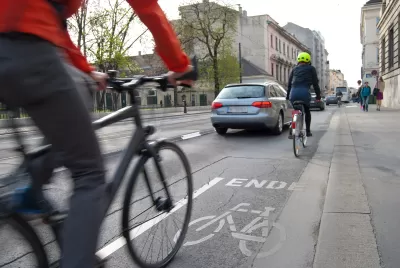The initiative focuses on safety, but fatalities are up and ridership growth is down in New York City. How is Vision Zero missing the mark?

"Vision Zero is failing to have a meaningful impact because it targets the wrong goal. The logical flaw here, at least as implemented in New York City, is quite basic: it is a policy that requires dead cyclists as a prerequisite to safety improvements," writes Aaron Gordon.
He uses data from New York City to make the case that Vision Zero is not making streets safer for biking and that the city only moves quickly to make changes after a cyclist is killed. There is safety in numbers, says Gordon, but the city has put in mostly unprotected bike lanes that do not provide the kind of safe infrastructure that draws people to biking.
"But safety isn’t the only factor. So are things like convenient, secure bike parking, timing traffic lights for cycling speeds for quicker and easier journeys, good road conditions, and sensible laws that acknowledge bicycles are not cars and should follow different rules," adds Gordon.
FULL STORY: Vision Zero Is The Wrong Goal

Maui's Vacation Rental Debate Turns Ugly
Verbal attacks, misinformation campaigns and fistfights plague a high-stakes debate to convert thousands of vacation rentals into long-term housing.

Planetizen Federal Action Tracker
A weekly monitor of how Trump’s orders and actions are impacting planners and planning in America.

In Urban Planning, AI Prompting Could be the New Design Thinking
Creativity has long been key to great urban design. What if we see AI as our new creative partner?

Cal Fire Chatbot Fails to Answer Basic Questions
An AI chatbot designed to provide information about wildfires can’t answer questions about evacuation orders, among other problems.

What Happens if Trump Kills Section 8?
The Trump admin aims to slash federal rental aid by nearly half and shift distribution to states. Experts warn this could spike homelessness and destabilize communities nationwide.

Sean Duffy Targets Rainbow Crosswalks in Road Safety Efforts
Despite evidence that colorful crosswalks actually improve intersection safety — and the lack of almost any crosswalks at all on the nation’s most dangerous arterial roads — U.S. Transportation Secretary Duffy is calling on states to remove them.
Urban Design for Planners 1: Software Tools
This six-course series explores essential urban design concepts using open source software and equips planners with the tools they need to participate fully in the urban design process.
Planning for Universal Design
Learn the tools for implementing Universal Design in planning regulations.
Appalachian Highlands Housing Partners
Gallatin County Department of Planning & Community Development
Heyer Gruel & Associates PA
Mpact (founded as Rail~Volution)
City of Camden Redevelopment Agency
City of Astoria
City of Portland
City of Laramie





























